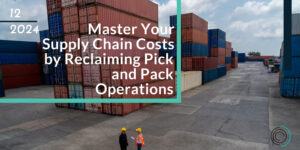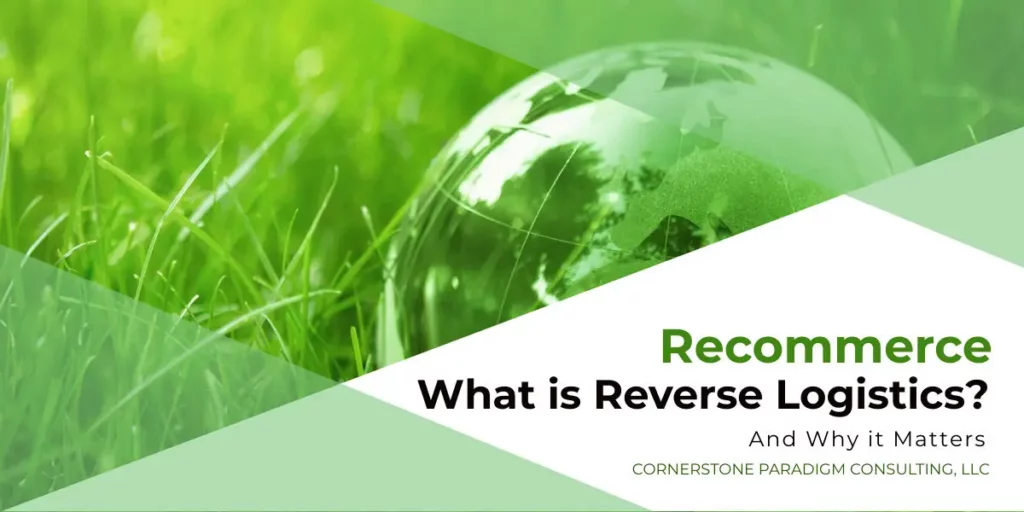Unlocking the Power of Reverse Logistics: How to Navigate Returns in the Era of E-Commerce and Sustainability
The shipping and logistics process doesn’t end when an item arrives with the end customer. In today’s world, the exponential growth of e-commerce has elevated the significance of returns, making them a crucial aspect for many customers. This shift in consumer behavior has led to returns being expected as part of the purchasing experience. Consequently, companies are faced with a myriad of challenges. These challenges encompass not only handling returns but also the practices of recycling, refurbishing, and recycling which have now become common practices for companies striving to meet customer expectations and environmental responsibilities.
Consumer spending habits and the way consumers allocate their finances have undergone a significant transformation in the past five years. The emergence of Gen Z has played a pivotal role in steering this change, often referred to as Recommerce. Furthermore, the ongoing pandemic has not only accelerated but also solidified this shift in consumer shopping behavior, emphasizing the growing importance of sustainable and value-driven choices in the marketplace.
We know Gen Z was raised with smartphones, social media, and online shopping; according to the National Retail Federation, 26% of Gen Z use Social Media to make purchases. Next, eBay reports that nearly 80% of their consumers purchasing secondhand goods are Gen Z. So, what does this mean for retailers? Gen Z has an estimated spending power of $323 billion according to CGS, and 15% of their purchases are on secondhand sites.
Any online retailer that wants to remain competitive can’t afford to ignore reverse logistics any longer but pulling it off without compromising revenue requires optimizing your processes carefully. Here’s what you need to know.
Recommerce and Reverse Logistics
Recommerce and Reverse logistics are two sides of the same coin. Recommerce is the process of reselling products that have been returned by customers, while reverse logistics refers to managing and processing those returns. However, reverse logistics also encompasses a much broader scope involving inventory management, supply chain optimization, and sustainability initiatives. This means that effective reverse logistics strategies can not only increase profits through resale opportunities but also reduce operational costs and improve environmental sustainability.
To successfully implement reverse logistics, companies need to have a well-planned and efficient process in place. This includes having a dedicated team or partner to handle returns, establishing clear return policies for customers, and tracking returned items through the supply chain. Implementing technology such as barcode scanning, data analytics, and automated systems can also streamline the returns process and reduce errors.
In terms of sustainability, companies can explore options like refurbishing products, recycling materials, or donating returned items to charity. These initiatives not only benefit the environment but also positively impact a company’s reputation and brand image. In addition, effective reverse logistics can lead to improved customer satisfaction and loyalty, as customers who have a positive return experience are more likely to continue shopping with the retailer.
Reverse logistics is no longer just an afterthought for companies but a crucial aspect of their overall supply chain and customer experience. With the growing importance of recommerce and sustainability, implementing effective reverse logistics strategies is essential for staying competitive in today’s market and meeting evolving consumer demands. By understanding the connection between recommerce and reverse logistics and utilizing efficient processes and technologies, companies can turn returns from a burden into an opportunity for growth. So, don’t overlook the power of reverse logistics in your business strategy – embrace it and reap the benefits.
The concept of circular economy is also gaining traction among businesses as they aim to minimize waste and maximize resources. This approach focuses on keeping products and materials in use for as long as possible through practices like recycling, refurbishing, and remanufacturing. Reverse logistics plays a crucial role in implementing circular economy principles, making it an integral part of sustainable business practices. As consumers become more environmentally conscious, companies that prioritize circular economy principles and reverse logistics will likely see increased customer satisfaction and loyalty.
What is reverse logistics?
Since logistics is all about the process of getting items from A to B, it makes sense that reverse logistics is about taking things from B back toward A. Or, perhaps not all the way back to A, but somewhere along the process (such as the retailer rather than the manufacturer) to give it a second lease of life. This can take various forms, including:
- Reselling items that consumers didn’t want
- Refurbishing or “upcycling” items (often for clothes)
- Repairing or replacing broken items (often for technology)
- Taking raw materials out of items to use them to make something else
- Recycling or disposing of items
Although reverse logistics primarily deals with handling products being returned by customers, it also encompasses items that never leave the warehouse. This can include surplus inventory being resold or redirected to other locations within the company’s network. Moreover, the concept extends to rentals and leasing scenarios, especially when equipment reaches the end of its contract term. Companies are then faced with decisions on whether to recycle the equipment, repair it for resale, or explore other sustainable disposal options.
Examples of reverse logistics
Amazon now has Amazon Warehouse, which allows customers to save money by purchasing products that have already been bought by someone else and returned. In some cases, items are classed as “like new” because a customer simply bought them and changed their mind (resulting in a small discount for the next consumer). In others, the item may have been used and damaged somewhat before the customer returned it, resulting in a worse condition and a greater discount.
Another interesting example is Levi Strauss, a well-known fashion brand that takes sustainability to the next level. They implement a unique approach by repurposing old jeans and utilizing the materials to craft new, stylish jeans for resale. This innovative strategy not only benefits the brand economically, turning discarded items into profits but also resonates with environmentally-conscious consumers who aim to reduce their carbon footprint.
A lesson in optimization
But what does any of this mean for you as a business owner? On the surface, most would agree that reverse logistics sounds like a great idea that can yield various benefits for consumers, society, and businesses alike. Consumers save money, contribute to sustainability efforts, and gain trust in brands that prioritize environmental responsibility. The environment benefits through reduced waste and carbon footprint, while companies not only gain an additional revenue source but also improve their reputation as socially responsible entities.
But pulling it off requires a whole new set of processes. Using the simple example of the Amazon customer who ordered an item and changed their mind, Amazon then has to collect that item to ship it back to the warehouse, have a process in place to verify its condition, and then figure out what to do with it. In some cases, there may be various options it needs to evaluate, such as reselling vs recycling vs throwing away.
Then there’s the complex question of whether the costs associated with returning an item may outweigh the potential value that can be reclaimed by initiating the return process. It is a common expectation among customers to have the option to return items; however, this practice can significantly influence a retailer’s revenue streams. Retailers often have to carefully consider the balance between customer satisfaction and the financial impact of returns. Moreover, the ease of the return process and the effectiveness of the customer service in handling returns can play a crucial role in shaping customer loyalty and repeat business.
Some e-commerce stores, such as Amazon, have opted to allow customers to keep products in situations where the items hold low value that doesn’t justify the expense of recalling them. This approach not only saves on operational costs but also enhances customer satisfaction and loyalty. Despite this, retailers must develop a robust system to effectively determine when to implement this practice, balancing cost efficiency with customer experience.
All in all, there’s a delicate balance between keeping customers happy, protecting revenue, and making the most out of resources. Processes are key to all of this.
To move forward, choose reverse
If you’re a retailer or e-commerce store, neglecting reverse logistics could put you at risk of alienating your customers and falling behind your competitors. If you’re unsure of how to adapt and protect your revenue, it may be helpful to bring a consultant on board to help you rethink your processes and do things as efficiently as possible. In today’s world, embracing reverse logistics isn’t just a trend; it’s a necessity for success. Why not consider embracing the opportunity to advance and optimize your resource utilization by integrating reverse logistics into your comprehensive business strategy? By leveraging the principles of reverse logistics, you can enhance operational efficiency, reduce waste, and improve sustainability practices within your organization.
By optimizing your processes, you can utilize this growing market and cater to the evolving consumer preferences of Gen Z. With their increasing spending power and demand for sustainability, reverse logistics may just be the key to unlocking success in the re-commerce marketplace. So don’t miss out on this opportunity and start incorporating reverse logistics into your business operations today!
Continuing the discussion on reverse logistics
While we have explored several examples of companies effectively implementing successful reverse logistics strategies, it is crucial to highlight that this process can indeed pose significant challenges for businesses to navigate. The successful integration of reverse logistics necessitates meticulous planning, thorough analysis of associated costs and benefits, and a profound comprehension of the customer journey and experience. By honing in on these critical aspects, organizations can enhance their operational efficiency and customer satisfaction levels significantly.
Furthermore, it is of utmost importance for companies to consistently monitor and adapt their reverse logistics procedures to guarantee optimal efficiency and effectiveness. This involves conducting regular assessments of various approaches (such as reselling versus recycling), and implementing modifications whenever necessary, to stay aligned with sustainability goals and enhance overall operational performance.
Another crucial factor to take into account is the significant impact that reverse logistics can have on a company’s comprehensive sustainability initiatives. By integrating environmentally friendly practices into their reverse logistics operations, companies can not only minimize waste and their ecological footprint but also bolster their reputation and attract environmentally conscious customers. This focus on sustainability in the reverse logistics framework can lead to long-term benefits for both the company and the environment as a whole.
With the growing shift towards sustainable consumer preferences, the importance of reverse logistics in shaping the future of e-commerce becomes unmistakably clear. In order to maintain competitiveness and build a successful, environmentally conscious business, it is crucial to integrate reverse logistics practices into your operational strategies. Take the first step towards sustainable success by delving deeper into the potential benefits of implementing reverse logistics solutions within your business operations today.
We are a dedicated business operations consulting firm that specializes in enhancing operational efficiency. Our approach involves meticulous analysis of business processes to identify areas for improvement, enabling us to develop tailored strategies that optimize overall performance. If you’d like to find out if we can help you take the right approach to reverse logistics, contact us to find out more.






